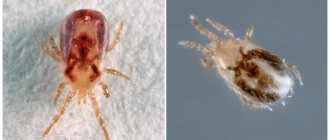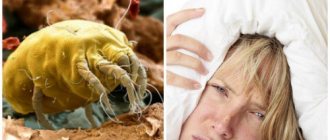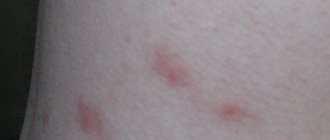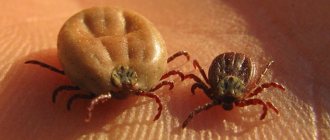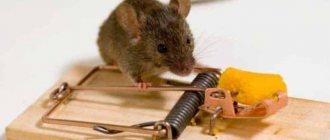Decorative rats, like other pets, are susceptible to parasitic diseases, despite the cleanliness and neatness of these animals.
If the animal’s behavior has changed and it often begins to itch, tearing the skin to the point of wounds, then these signs should in no case be ignored.
In most cases, they indicate an invasion that causes serious discomfort to the pet and prevents it from living a normal life.
- 3.1 Fleas in rats
Ways of infection of decorative rats with ectoparasites
Infection mainly occurs through direct contact with a sick animal. Carriers can be cats, dogs and other pets.
Infection is also possible when using natural fillers in the cage. Many inexperienced owners of ornamental animals prepare their own material at sawmills. This filler does not undergo special treatment and may become contaminated.
It also happens that a person himself carries ectoparasites on his clothes, and when they get into the house, they quickly find a suitable biological host in the form of a decorative rat.
Infection of residential premises
Unfortunately, situations are possible when rat and mouse parasites infect apartments. This is a truly serious problem that requires the help of specialists. The first thing you need to do is make sure that the room is infested with rat mites. This can be done by a disinfectant. In the event that infection is confirmed, disinsection is carried out.
When carrying out disinfestation, potent drugs are used that are aimed at getting rid of parasites. In this case, it is necessary to treat all possible locations of insects. In cases where pets live in the house, be sure to visit a veterinarian who will recommend a remedy for treatment.
It is very important in this situation to find the cause of the infection; if this happened due to the presence of mice and rats in the basement, then this room must also be treated, since the situation will repeat itself.
How to recognize the presence of parasites in a rat?
This animal is susceptible to attack by several types of ectoparasites. The life activity of each of them causes discomfort, which negatively affects the general condition of this pet.
Ticks
Even laboratory tests at the initial stage of invasion do not always help to identify subcutaneous mites in rats, since scrapings taken give a false negative result. Only later do signs appear that indicate invasion.
Decorative rats can be parasitized by several types of mites, which can be recognized by their characteristic symptoms.
Sarcoptes scabiei
Among them:
- Sarcoptes scabiei. Peeling and scratching appear in the head, ears, neck, and upper back.
- Notoedres cati. The invasion is characterized by papules, blisters, yellowish crusts, and wart-like growths on the ears, nose, tail, and genitals.
- Demodex aurati. Infection can be recognized by the formation of dandruff and scabs on the skin.
- Ornithonyssus bacoti. In this case, all the signs of rat tick-borne dermatitis appear. The infestation is also accompanied by severe itching.
lice eaters
The size of these ectoparasites does not exceed 1 mm. Lice eaters have an elongated, red-colored body covered with bristles. It is quite difficult to see them in the animal’s fur, but the infection can be identified by the presence of light-colored eggs that are attached at the base of the hair.
When lice eaters appear on a decorative rat, the animal becomes restless, rushes around the cage and refuses its usual treats. Lack of treatment leads to exhaustion of the pet and can cause its death.
Lice
Only one type of lice can parasitize decorative rats - Polyplax spinulosa. They can be detected by the nits that females attach to the animal's fur. Parasites feed on blood, which is why red, inflamed dots appear at the bite sites. The parasites themselves can only be seen under a microscope. Rat lice have an elongated red body, the length of which does not exceed 0.5 mm.
Fleas
Most often, fleas appear when animals live together with cats and dogs in the same apartment. Parasites live on the skin of an animal and feed on its blood. Fleas have an elongated body measuring from 2 to 5 mm, brown color, 3 pairs of limbs, thanks to which they are able to jump up to 1.2 m.
These ectoparasites leave red discharge on the rodent's body, so when your pet is bathed, the water turns pink.
Fleas
Bedbugs
Bed bugs, in the absence of another food source, can attack decorative rats. Their bites cause severe itching, anemia, and scratching. Parasites are active only at night, when they leave their shelters in search of food.
Bed bugs on rodents
Bedbugs are very rarely found on pet rats. Like fleas, a rat will only have bedbugs if another pet (such as a dog or cat) has them.
Make sure all your non-rat animals are on a high-quality flea (and bedbug, if necessary) preventative. Over-the-counter products are not always effective or safe. The best flea and bedbug treatments are recommended by your veterinarian. If your dogs and cats don't have fleas and ticks, then your rats shouldn't have them either.
Parasitic diseases of rats
In decorative rats, parasitic diseases caused by fleas, lice, and lice are most often diagnosed. The reason for this is the lack of regular treatment of cells and household items, and unbalanced nutrition.
Fleas on rats
The causative agent of flea infestation in decorative rats is ectoparasites from the order Siphonaptera. This disease is diagnosed as aphanipterosis. It is accompanied by dermatitis, since flea saliva contains toxic substances that cause allergies in the rodent.
The danger of flea infestation is that one flea can drink up to 11–16 μl of blood per day. And with mass reproduction, this can cause anemia in a decorative rat.
Aphanipterosis is accompanied by itching, which leads to scratching on the skin. When bacteria and infections get into open wounds, they begin to fester. This leads to a chronic relapsing course of the disease.
Lice and lice in rats
Infection of a decorative rat with lice and lice-eaters is diagnosed as pediculosis. The incubation period of the disease can last about a month.
Main symptoms of the disease:
- constant itching;
- red dots, scratches in the muzzle, neck, shoulders;
- anemia, causing weakness, drowsiness;
- refusal to eat;
- sudden weight loss.
The danger of pediculosis is that its pathogens are also carriers of diseases such as typhus and hemobartonellosis.
Weight loss
Treatment of an infected rat
Specifying the type of parasite and prescribing treatment should be carried out by a specialist in a veterinary clinic, since different medications are used to destroy external and subcutaneous parasites. In case of complications, the animal is prescribed anti-inflammatory ointments, immunostimulating drugs and a course of vitamins and antibiotics.
Insecticidal preparations are highly toxic; if handled incorrectly or in excess of the dosage, there is a risk of poisoning a decorative rat. It is advisable that the animal be treated by a veterinarian; it is also permissible to treat a furry pet at home in a well-ventilated area, strictly following the recommendations of a specialist.
At the same time as treating your pet, you need to throw away the bedding, disinfect the cage and all accessories several times, change the filler, and treat the entire room with repellents. It is advisable to throw away all wooden objects from the cage; they can be places where parasites accumulate. The rodent's claws should be trimmed short during treatment to prevent scratching of the skin.
When keeping domestic rats in groups, all rats must be treated repeatedly to avoid re-infection. If a pet is bitten by fleas or bedbugs, it is recommended to treat all pets living in the house with insecticides, as well as the room itself: carpets, upholstered furniture, mattresses, floors, etc.
Basic drugs for ectoparasites and methods of their use
If it is possible to determine which parasites cause discomfort to the decorative rat, it is necessary to carry out treatment. It is based on the use of special drugs.
Of the things that can be used to treat a rat against parasites such as lice, lice, fleas, bedbugs, the most popular are:
- Unoiled. To treat a rodent, you need to dilute 2 ml of the product in 400 liters of warm water and mix thoroughly. Soak a cotton pad in the resulting solution and gently apply it to the entire body of the rodent, paying special attention to inflamed areas.
- Spray Frontline. To treat a decorative rat from external parasites, you can only use an aerosol from this series of drugs, as it has a gentle effect. During the treatment process, you need to spray the product twice on the withers of the rodent, holding it in your hands.
- Spray Bars. This drug should be used in the same way as the previous one. In addition, you additionally need to moisten a cotton pad in the product and wipe the inflamed areas on the body with it.
After treatment with any of the listed drugs, you should wrap your pet in a towel and hold it in your hands until it is completely dry, without allowing it to lick itself. After this, rinse the wool with warm water and then dry it with a hairdryer. If necessary, repeat the treatment after 7-10 days.
To rid an animal of ticks, you need to apply the following drops to the withers:
- Stronghold;
- Advocate;
- Prazicide-complex;
- Fiprist;
- Dana.
Before treating your pet, you must first trim its claws to prevent severe scratching of the skin. For treatment, just apply 1 drop of the product and lightly rub into the skin.
On the same day, you need to treat not only the pet, but also its cage. You should also replace the bedding and disinfect his household items.
Stronghold
Medicines to get rid of parasites
All medications used must be prescribed by your veterinarian. If your veterinarian has not examined your rats in the last month or so, an examination is an important first step to making a diagnosis and prescribing the proper medications. Finally, it is safer to purchase all medications from your veterinarian rather than online or at a human pharmacy.
Your veterinarian will likely prescribe Ivermectin to help get rid of parasites. This medication should be administered topically or orally. Injectable Ivermectin can also be used topically by placing the appropriate dose on the rat's neck and allowing the rat to lick itself. Then the animal will be able to swallow the product.
Do not use the medicine on infants or pregnant or lactating females without the prior approval of a veterinarian.
The product can be used once every 10–14 days, for a total of three procedures. During storage, Ivermectin for injection should be kept away from direct light.
All pets should be treated, even if some are asymptomatic. Some rats itch and others don't, but that doesn't mean they don't need to be treated. In addition to treating your rats, you will need to thoroughly clean the cage (1 part bleach to 10 parts water is recommended), throw away all trash, wash all fabric materials in the cage, and get rid of any wooden toys that are not sealed. If you have unused bedding or litter, you should freeze the bag for up to 24 hours before using it to kill any lice or mites that may be living in it.
You should notice fewer scratches and scabs on your pet's body within 2-3 days of the first treatment. Water often helps soothe a rat's skin. Trimming your rat's nails can also help the scabs heal faster.
Prevention of parasites
- Cleaning
If you suspect all rats have parasites, you should completely empty their cage, clean and disinfect all contents, as well as the cage itself. Throw away anything wooden or cardboard inside the cage. If there is carpet in the room, it is worth having it professionally cleaned if possible. Professional carpet cleaners are usually relatively inexpensive and can clean carpets in a very short time.
In any case, it is recommended to clean and disinfect the cage and its contents at least once a week.
- Caring for Rat Paw Nails
Keep your rat's toenails trimmed to prevent scratches and wounds they may inflict on themselves. Damaged skin caused by scratches allows bacteria to enter. Once the scabs form, the rats begin to itch. This leads to a vicious cycle of more scratches, skin damage, bacteria and scabs. Some rats need their toenails trimmed once or twice a week.
